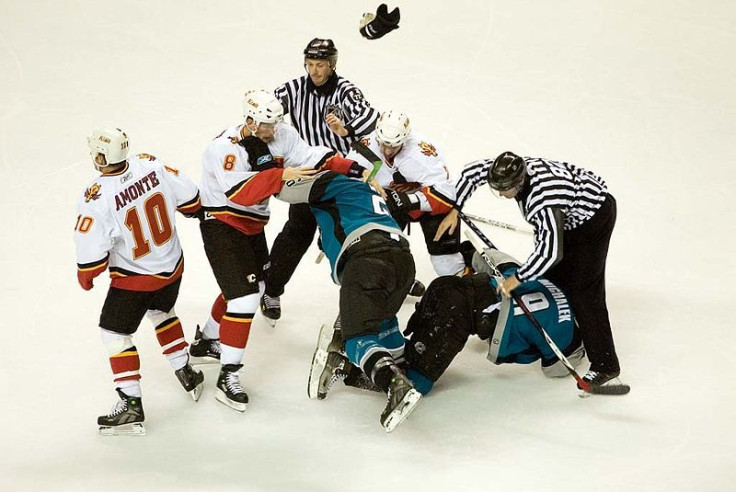Should NHL Ban Hockey Fights?: Brawls May Lead To Severe Brain Damage In Players

The days of yelling, screaming, and cheering on your favorite National Hockey League (NHL) team fighting the opposing team could be limited. Hockey fights have been synonymous with the sport as fans expect at least one fight to break out in a single game.
In October, researchers gathered at the Ice Hockey Summit II: Action on Concussions Mayo Clinic conference to discuss the physical and mental health dangers hockey fights may have on the league’s players. In an attempt to reduce concussion risk and improve injury diagnosis, Dr. Michael Stuart, a director of the Mayo Clinic Sports Medicine Center and the chief medical officer for USA Hockey proposed automatic ejections and suspensions should replace five-minute fighting penalties during a game.
Dr. Stuart bases his proposal on the NHL opening-night fight when Montreal Canadiens’ George Parros was hospitalized after being knocked unconscious in a fight, the New York Times reports. “They frequently fall, their helmet may come off, maybe their arms are pinned and the opponent falls on top of them, then their head hits the ice. Those forces acting on the brain are alarmingly high,” he said.
In an effort to lower the rates of concussions among its players, the league introduced “Rule 48” in 2010. The rule aims to regulate bodychecking to the head by prohibiting lateral and blind side hits to an opponent targeting the head. However, the introduction of the recent rule has not help keep concussion rates down.
In a study published in the journal PLOS One, Canadian researchers found just as many players continued to incur mild traumatic brain injuries in the two seasons following the implementation of Rule 48. Although the rates of concussions appeared to remain the same, the researchers believe the league may simply need more time for the rule to take full effect as it could potentially change the style of playing the game.
The NHL continues to be under fire due to the recent fight that broke out between Philadelphia Flyers goaltender Ray Emery who skated the whole rink to fight against Washington Capitals goaltender Braden Holtby during the third period. Currently, the league does not have a specific rule to punish Emery for what he did. The rules do not go beyond one game suspension for misconduct and 29 penalty minutes.The NHL is discussing the possibility of giving any goalie who leaves their zone to fight a 10-game suspension, says NBC Sports.
Unlike the NHL, European leagues and tournaments are regulated by the International Ice Hockey Federation. Under the Federation, fighting is punishable by ejection from the game along with a five-minute major penalty. If the NHL were to go that route and consider suspensions, they could drastically reduce fist-related incidents.
While researchers support the implementation of a fighting ban in the game, others like Brian Burke, the Calgary Flames’ president of hockey operations, believes it will take away the essence of the overall sport. “The fact of the matter is I think this game is safer with fighting in it,” said Burke, The Hockey News reports. “The amount of fighting in the game has been reduced dramatically, and that’s a good thing. It’s not going to go up, but I think it’s a central part of player safety.”
Burke’s sentiment is echoed across the NHL by 98 percent of players who were against abolishing fighting in a NHLPA/CBC poll. This poses a challenge for rules increasing the punishment for fighting to be supported by the players.
At the start of this season, the league was proactive in ensuring player safety by having all incoming players and those with 25 or fewer NHL games to wear visors. Prior, players who wore a visor would be given an extra penalty for initiating a fight. Now there is only a two-minute minor if the fighters remove their helmets directly before a fight.
NHL Commissioner Gary Bettman told the CBC the visor rule was “purely a safety issue because we don’t want players getting hurt needlessly.”
New York Rangers star forward, Rick Nash, has been on leave indefinitely after suffering a non-fight related concussion after being staggered by an elbow to his jaw by San Jose Sharks defenseman Brad Stuart. According to the NY Daily News, Nash struggled to the bench in the third minute of the game but skated for the rest of the first period before leaving the game for good. NHL concussion protocol states a concussed player should be taken to the examination room immediately, something the Rangers failed to do.
USA Hockey says concussions in hockey occur after a direct blow to the head, face, neck or body. The force causes the brain to shift and immediately impacts symptoms such as confusion, amnesia, loss of consciousness, and loss of balance, among many others. Players to have multiple concussions may be susceptible to the snowball effect — possibly suffering long-term brain damage.
With the wide array of information made readily available to the NHL, only time will tell if the league will ban hockey fights for good.



























